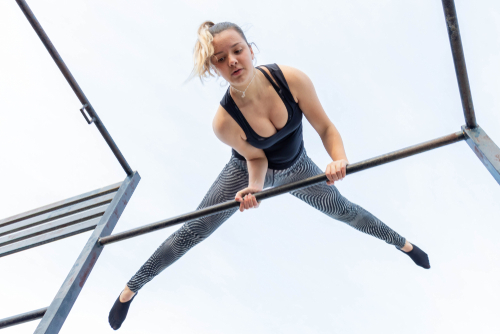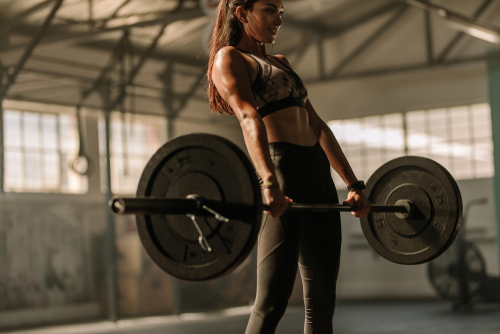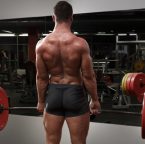Strength training and strength-enhancing exercises have been proven time and time again to be the optimal method for losing weight, gaining muscle, and improving your overall athletic performance as well as physical appearance compared to cardiovascular exercises.
What’s unclear, however, is if this is the same whether you’re using pre-established weights, from bodybuilding and weightlifting, or your ever-changing bodyweight, via calisthenics.
Below, we’ll go into both methods of physical training, including their respective strengths and weaknesses, and ultimately come to a conclusion on which of the two will give you your optimal physical results.

Key Takeaways
- Calisthenics is a form of strength-based exercise whereby the person uses their body weight rather than outside physical weight.
- Calisthenics has many benefits, including that it is easy and cost-effective, can improve core and body movements, and includes cardio benefits.
- However, calisthenics also has some drawbacks, such as being challenging for overweight or obese people, difficulty in increasing intensity or progression, and not ideal for building muscle mass.
- Weight training strengthens the body by using additional outside weights as resistance.
- The benefits of weight training include that it is easier to build muscle mass, can strengthen specific muscle groups,and will burn fat much faster.
What Are Calisthenics?
Starting with the easier of the two, calisthenics (or “calisthenics” in the UK) is a form of strength-based exercise whereby the person uses their body weight rather than outside physical weight. Originally performed by the ancient Greeks, calisthenics primarily includes standard beginner exercises like pushups, crunches, and pullups, as well as more advanced exercises like burpees, planks, and dips.
Ultimately, bodyweight training is meant to improve your physical strength in relation to your physical body weight while also helping improve both flexibility and coordination.
What Are The Major Benefits Of Calisthenics?
#1. Ease & Cost-Effectiveness
Arguably the biggest benefit that comes from regular calisthenics is the fact that you don’t need a gym membership to perform them. In fact, with the exception of gym clothes, a potential-jump rope or pullup bar, and an optional gym mat, you don’t need anything outside of a bit of space and a towel.
This can mean working out at your home, a park, or even in between your lunch break at the office.
Not only that, but calisthenics isn’t especially complex or complicated. While form is certainly an important factor, it is much easier to do an effective pushup than it is a bench press — and a lot safer as well.
#2. Improved Core & Body Movements
Another huge benefit that comes from bodyweight exercises is that they are great for strengthening one’s core as well as flexibility and body movements. This is because almost every exercise requires a level of balance that can only be achieved through strong core muscles.
Similarly, because many exercises also require a full range of motion from different muscle groups in the body, calisthenics can help improve coordination and flexibility much more effectively compared to using weights.
#3. Includes Cardio Benefits
Lastly, one of the more surprising factors behind calisthenics is the fact that they also offer many of the same cardio-based benefits someone would expect to receive if they were jogging or performing other cardiovascular exercises.
This is because, while calisthenics is primarily a strength-based form of exercise because you are using your entire body as well as strengthening your core, they can also be counted as cardio exercises!
As a result, you can expect a reduced risk of cardiovascular disease as well as an improvement in your heart and lung health.

What Are The Major Drawbacks Of Calisthenics?
#1. Challenging For Overweight & Obese
Starting with a sobering fact for many beginners out there, while calisthenics has a lot of upsides, it may be a bit of a challenge for those that are heavier set.
While a few extra pounds overweight isn’t going to strain things too much, the same can’t be said for those that are overweight or obese. This is because, as mentioned earlier, calisthenics is built around building your strength up using your existing bodyweight. This means that, between two beginners, the skinnier person is going to have an easier time completing calisthenics compared to someone who has two, three, or four times as much bodyweight to carry.
The good news is that calisthenics also doubles as cardio, meaning that persistent effort will reduce one’s weight relatively quickly.
Still, between the increased weight placed on your wrists and joints (as well as your muscles), you may want to be very careful when starting out using bodyweight exercises.
#2. Difficult To Increase Intensity Or Progression
On the other hand, for those that already know what they’re doing, calisthenics can easily become very dull after a while. Because you’re only lifting your body weight, it’s very difficult to ramp up the intensity or steadily increase progression. For most, you’re going to have to become an expert before risking any of the more advanced (and dangerous) forms, such as handstand pushups or hanging sit-ups.
#3. Not Ideal For Building Muscle Mass
Lastly, if you’re someone that is looking to “bulk up” or see yourself as larger or physically more imposing, calisthenics may not be the route to go. An easy example of this can be seen between a gymnast and a bodybuilder. Despite both individuals spending hours in the gym, a gymnast is much smaller and less imposing compared to a bodybuilder.
This is because, as great as calisthenics are for increasing strength and increasing your metabolism, it’s not meant as something that is going to bulk you up or give you a lot of muscle mass. Again, you have to remember that you’re strengthening your muscles in relation to your body weight. That means there’s only so big your muscles can grow before they instead focus almost exclusively on strengthening.
What Is Weight Training?

Where calisthenics can be defined as strength training while using your bodyweight as resistance, weightlifting instead strengthens the body using additional outside weights as resistance.
Lifting weights is an excellent option for those that want to see real tangible results with their physical strength as well as their overall size. This is because, unlike with calisthenics, weight lifting specifically allows you to control exactly how much stress your muscles are put under, essentially expediting the muscle-building process.
There are two primary methods of weight lifting; free weights and weight machines. Free weights are generally regarded as being more difficult while also offering greater results. Machine weights, on the other hand, are much easier to use, though often resulting in less impressive overall gains.
What Are The Major Benefits Of Weight Training?
#1. Easier To Build Muscle Mass
Let’s start with the most obvious reason you’d want to do weightlifting: the increased muscle mass. There’s no doubt about it, folks. While calisthenics can get you a ripped look like Spiderman, weightlifting can get you jacked like Thor, Hulk, or Thanos.
As mentioned earlier, weight training does this by overloading your muscles through outside weight resistance (i.e., the weights you lift). This allows you to continually and progressively cause your muscles to atrophy, ultimately growing larger and stronger as a result.
This is something that, while not impossible, is much longer and more difficult when only using your body weight.
#2. Can Strengthen Specific Muscle Groups
Whether it’s leg presses for your lower body or focusing solely on your biceps, triceps, or upper body, weight training is unique in its ability to “spot focus” or isolate your attention on building up a specific part of your body. This is largely the case when it comes to weight machines, though this can also be done with barbells.
When performing calisthenics (even something as simple as a pushup), you are using your entire body. Yes, your focus may be on your arms or your legs, or your core, but virtually all of your movements require your entire body to be engaged to some degree. This results in every part of you getting its minor workout.
Weight training isn’t nearly as involved. Particularly with weight machines, since the weight comes from an outside source, the only body part that is engaged in the one being focused, on, no other part of your body is being bothered. Not only does this make resting those areas easier, but it also can ensure a weaker side or area can “catch up” to the rest of your body.
#3. Will Burn Fat Much Faster
Interestingly enough, weightlifting is also a great method of losing weight. While a bit different from calisthenics, both methods do help with burning fat and losing weight. In the case of weight lifting, however, this is done simply through the act of building muscle rather than working to actively keep your metabolism running as much as possible.
Not only does the physical act of building muscle in the first place help burn calories and fat, but you burn between 6 and 10 calories a day per pound of muscle you have. This means that a person with 10lbs of muscle is constantly burning at least 60 calories without doing anything. When considered in addition to actual time in the gym, you can see why so many bodybuilders also don’t have a lot of fat on their bodies.
While calisthenics is a great option for many, it doesn’t result in achieving those same levels of muscle mass, meaning you likely won’t get as big, thus won’t have that daily 6-10 calorie deficit, instead needing to work longer and more intensely to keep the metabolism as high as possible and running as fast as possible.

What Are The Major Drawbacks Of Weight Training?
#1. Much More Expensive & Dangerous
Though not quite as many, there are drawbacks to weight training, and they can often be quite dangerous. The most noteworthy setbacks when it comes to weight training are the cost as well as the danger factor.
Just as calisthenics only requires a bit of space and some workout clothes, resistance training often needs you to have a gym membership or have a fairly open workout space available. While a gym membership doesn’t necessarily have to be expensive, it is certainly more expensive than the “FREE” that calisthenics offers. This is made more apparent if you consider establishing a home gym, which can be hundreds of dollars on the short end, to thousands of dollars (to even tens of thousands) on the more expensive side. Again, this is a heck of a lot more than Free.
Even if you go the commercial gym route, you’re likely going to need to pay for a personal trainer to make sure you don’t have any issues, either teaching you proper form or just acting as a spotter. Many ego lifters and people not willing to invest in a teacher have suffered serious injuries trying to lift weights, often lifting incorrectly or simply not having the strength to keep it lifted.
#2. Reduced Flexibility & Range Of Motion
Just as calisthenics will result in flexibility but not large muscles, the inverse is also true. Here, you can expect to gain some impressive muscles, but lose out on the same degree of flexibility and physical range of motion. As you can imagine, this is because your muscles can become simply too big at a certain point, making bending them more difficult than if they were smaller or simply more defined.
#3. Monotonous
Lastly, while all exercises can eventually be boring, weightlifting, in particular, can become especially monotonous. This is because you’re pretty much just lifting a weight up and down over and over again. In fact, for many beginners going by themselves, the monotony of it may seem a bit disappointing or even confusing (often, thinking “is that it?”).
You may get a bit of motivation by seeing your weights slowly increase, but nothing expressly exciting is going to happen from lifting weights.
Related: The 11 Calisthenics Exercises That Build The Most Muscle
Related: The Complete Guide to Calisthenics and Bodyweight Exercises
Calisthenics vs Weights: Which Is The Best Option For Me?
Calisthenics and weight training both have their respective pros and cons. As such, it depends on what your end goal is for your body.
If you’re more interested in increased endurance, improved cardio health, and a slimmer, sleeker appearance, calisthenics is the optimal way to go. On the other hand, if you’re more interested in a bulkier frame with stronger muscles and a well-developed lower body, it may be better to spend more time with the machines and free weights.
Of course, you can always get the best of both worlds by mixing up your workout and implementing calisthenics as well as weights into your exercise routine. This ensures a stronger and bulkier body that is more flexible and with a stronger core.
If you’re interested in setting up a home gym, and reaping all of the fitness benefits without leaving your home, consider checking out some different options for home gym machines here.
Links & Cited Sources
- Increasing muscle mass to improve metabolism – PMC (nih.gov)
- The Importance of Muscular Strength in Athletic Performance – PubMed (nih.gov)
- Optimal body weight for health and longevity: bridging basic, clinical, and population research – PMC (nih.gov)
- Cardiovascular Effects and Benefits of Exercise – PMC (nih.gov)

Ryan is a former college wrestler and lifelong fitness fanatic with over 25 years in the industry. He’s run half marathons, tackled mud runs, placed in body transformation contests, and coached everything from wrestling to girls’ soccer.
Along the way, he’s tested hundreds of supplements and built a deep well of supplement knowledge. His work has appeared in Muscle & Strength, Testosterone Junkie, The Sport Review, and more. Today, he’s the editor-in-chief of this site, still training hard and helping others reach their goals. Connect with him on LinkedIn below.








